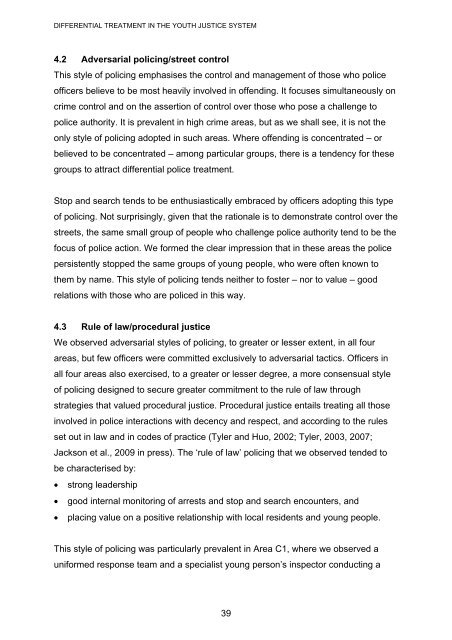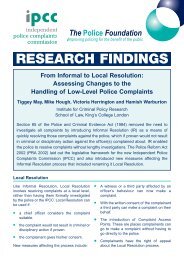Differential treatment in the youth justice system - Equality and ...
Differential treatment in the youth justice system - Equality and ...
Differential treatment in the youth justice system - Equality and ...
You also want an ePaper? Increase the reach of your titles
YUMPU automatically turns print PDFs into web optimized ePapers that Google loves.
DIFFERENTIAL TREATMENT IN THE YOUTH JUSTICE SYSTEM4.2 Adversarial polic<strong>in</strong>g/street controlThis style of polic<strong>in</strong>g emphasises <strong>the</strong> control <strong>and</strong> management of those who policeofficers believe to be most heavily <strong>in</strong>volved <strong>in</strong> offend<strong>in</strong>g. It focuses simultaneously oncrime control <strong>and</strong> on <strong>the</strong> assertion of control over those who pose a challenge topolice authority. It is prevalent <strong>in</strong> high crime areas, but as we shall see, it is not <strong>the</strong>only style of polic<strong>in</strong>g adopted <strong>in</strong> such areas. Where offend<strong>in</strong>g is concentrated – orbelieved to be concentrated – among particular groups, <strong>the</strong>re is a tendency for <strong>the</strong>segroups to attract differential police <strong>treatment</strong>.Stop <strong>and</strong> search tends to be enthusiastically embraced by officers adopt<strong>in</strong>g this typeof polic<strong>in</strong>g. Not surpris<strong>in</strong>gly, given that <strong>the</strong> rationale is to demonstrate control over <strong>the</strong>streets, <strong>the</strong> same small group of people who challenge police authority tend to be <strong>the</strong>focus of police action. We formed <strong>the</strong> clear impression that <strong>in</strong> <strong>the</strong>se areas <strong>the</strong> policepersistently stopped <strong>the</strong> same groups of young people, who were often known to<strong>the</strong>m by name. This style of polic<strong>in</strong>g tends nei<strong>the</strong>r to foster – nor to value – goodrelations with those who are policed <strong>in</strong> this way.4.3 Rule of law/procedural <strong>justice</strong>We observed adversarial styles of polic<strong>in</strong>g, to greater or lesser extent, <strong>in</strong> all fourareas, but few officers were committed exclusively to adversarial tactics. Officers <strong>in</strong>all four areas also exercised, to a greater or lesser degree, a more consensual styleof polic<strong>in</strong>g designed to secure greater commitment to <strong>the</strong> rule of law throughstrategies that valued procedural <strong>justice</strong>. Procedural <strong>justice</strong> entails treat<strong>in</strong>g all those<strong>in</strong>volved <strong>in</strong> police <strong>in</strong>teractions with decency <strong>and</strong> respect, <strong>and</strong> accord<strong>in</strong>g to <strong>the</strong> rulesset out <strong>in</strong> law <strong>and</strong> <strong>in</strong> codes of practice (Tyler <strong>and</strong> Huo, 2002; Tyler, 2003, 2007;Jackson et al., 2009 <strong>in</strong> press). The ‘rule of law’ polic<strong>in</strong>g that we observed tended tobe characterised by:• strong leadership• good <strong>in</strong>ternal monitor<strong>in</strong>g of arrests <strong>and</strong> stop <strong>and</strong> search encounters, <strong>and</strong>• plac<strong>in</strong>g value on a positive relationship with local residents <strong>and</strong> young people.This style of polic<strong>in</strong>g was particularly prevalent <strong>in</strong> Area C1, where we observed auniformed response team <strong>and</strong> a specialist young person’s <strong>in</strong>spector conduct<strong>in</strong>g a39






